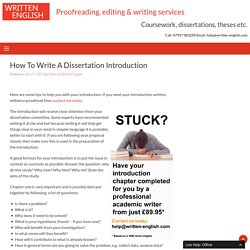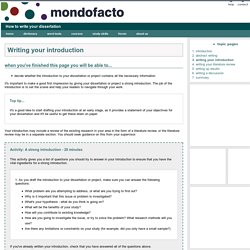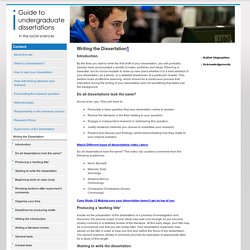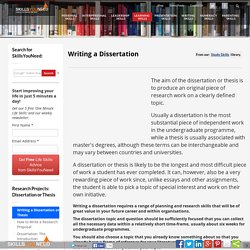

Structure Of A Dissertation. The first question which occurs to most people is “What should my thesis look like?”

Most departments deposit good examples of theses in the Library for students to look at. Some tutors keep copies of previous good work. There are also some MBA examples online on the University of Bolton’s repository. Your dissertation should state the objectives of your investigation, describe your research methods, and present and discuss your results. Generally, this is achieved using the structure below. Dissertation Structure - a Guide. Dissertation Structure. Based on BS 4821: 1990 the recommended sequence is as follows.

The items in italics may not be relevant for your project and the following sections will try to explain the items most likely to be needed in your dissertation. Preliminary pages, consisting of: Title page Abstract or summary (one separate page) Acknowledgement Author’s declaration Contents List of Figures List of Tables List of accompanying material (e.g. software on a disc or CD) Definitions Body of the dissertation divided into chapters, sections, etc. The Introduction Chapter A Justification of the Research Methods Used Chapters Comprising a Review of Literature The Results Chapter The Analysis Chapter The Discussion Chapter The Conclusions Chapter The Future Work Chapter References Bibliography (if required) Appendices (if required) Glossary (if required)
Structure of a dissertation. James Atherton These notes originate from my efforts to help an old friend undertaking a taught Master's course, at a university which seemed to devise its regulations around the key principle that under no circumstances should, or could, a supervisor be helpful.

So my reaction to his first almost complete draft was to say that it needed to be completely re-organised; it was great content, but did not follow the conventions of a dissertation. Quite reasonably he asked how he was supposed to know that? This is a game he would only play once, whereas supervisors and assessors and external examiners are familiar with it. He suggested, "I should have found (useful) a model outline for the MA, like Intro could include..........and should not...... So this is my attempt to provide just that. Note that these are general remarks, and that they are trumped by any specific rubrics from the awarding institution.
Preliminaries Title page, including Abstract Introduction Literature Review Methodology. How to Write a Dissertation Introduction. Here are some tips to help you with your introduction.

If you need your introduction written, edited or proofread then contact me today. The introduction will receive close attention from your dissertation committee. Some experts have recommended writing it at the end but because writing it will help get things clear in your mind in simpler language it is probably better to start with it. If you are following your proposal closely then make sure this is used in the preparation of the introduction. A good formula for your introduction is to put the issue in context as concisely as possible. Writing your introduction - How to write your dissertation.
When you've finished this page you will be able to... decide whether the introduction to your dissertation or project contains all the necessary information It's important to make a good first impression by giving your dissertation or project a strong introduction.

The job of the introduction is to set the scene and help your readers to navigate through your work. Dissertation Introductions. An introduction is different from an abstract, but is no less important.

The main differences between abstracts and introductions are as follows: Introduction: This introduces the field and creates a setting for the research. Abstract: This is a separate, self-contained summary; it focuses on providing a representation of the whole article, thesis or dissertation. Introductions provide reference to previous research.
AW Guide 2 Diss Introductions etc. Writing the Dissertation. Writing the Dissertation1 Introduction By the time you start to write the first draft of your dissertation, you will probably already have accumulated a wealth of notes, scribbles and ideas.

Planning is essential, but do not be hesitate to draw up new plans whether it is a brief abstract of your dissertation as a whole, or a detailed breakdown of a particular chapter. This section looks at effective planning, which should be a continuous process that intensifies during the writing of your dissertation and not something that fades into the background. Dissertation proposals & writing dissertations: Introduction. QRG Format your dissertation in a flash. Writing a dissertation. How to write your dissertation.
Once you have your outline sorted and you've got a pile of research notes together, it's time to knuckle down and start writing.

You need not necessarily start at the beginning – in fact, introductions are often easier to write at the end when you know how your argument has developed. Get going on the bits you know you'll find easy, then use your outline to put them together in the right order. You'll find areas that need further research, so be prepared to revisit the library as you're going along. Your style of writing is crucial to communicating your ideas effectively. A well-planned and researched dissertation can be let down by poorly expressed ideas or unclear phrasing.
Writing up your dissertation - University of Reading. This guide covers how to get your dissertation successfully written up in the time you have.

It includes advice on: Printable version of this guide (this is designed to be printed double-sided on A4 paper, then folded to make an A5 leaflet). Managing your time Don't panic! Writing a Dissertation or Thesis. The aim of the dissertation or thesis is to produce an original piece of research work on a clearly defined topic.

Usually a dissertation is the most substantial piece of independent work in the undergraduate programme, while a thesis is usually associated with master's degrees, although these terms can be interchangeable and may vary between countries and universities. A dissertation or thesis is likely to be the longest and most difficult piece of work a student has ever completed. It can, however, also be a very rewarding piece of work since, unlike essays and other assignments, the student is able to pick a topic of special interest and work on their own initiative. Writing a dissertation requires a range of planning and research skills that will be of great value in your future career and within organisations. There are many ways to write a dissertation or thesis. How to write a dissertation. 1.03 How to write a dissertation Your topic : Planning and research : Structure of dissertation : Content and style : Referencing The advice given here is very general in nature: you must always check with your supervisor and with course documentation what the specific requirements are on your course.
A good dissertation will: have a clear objective, based on a well worked out thesis or central question. be well planned and widely researched. show that the student has a good grasp of relevant concepts and is able to apply these in their own work. include analysis, critical evaluation and discussion, rather than simple description. contain consistent and correct referencing. be structured and expressed in an appropriate academic way. Writing a dissertation. For a printer-friendly PDF version of this guide, click here This Study Guide addresses the task of writing a dissertation. It aims to help you to feel confident in the construction of this extended piece of writing, and to support you in its successful completion. You may also find the following Study Guides helpful: Introduction Sometimes writing is seen as an activity that happens after everything else: “The research is going well, so the writing should be straightforward - I can leave it until later”.
These four very different perspectives lead to the same potential problems: regarding re-drafting as a failure or a waste of time;ignoring the further learning and clarification of argument that usually occurs during the writing and re-writing process; andleaving too little time for effective editing and final proofing. Getting on with the writing The good news is that you have already started writing if you have written any of the following in relation to this study: Check out what is required. Dissertation structure. Dissertations offer you a great opportunity to investigate a topic of particular interest to you with a view to discovering new knowledge or new practice. TIP - Firstly, there are different types of dissertation so ensure you read your dissertation assignment brief carefully to see what you are expected to do.
We will cover the following topics in this guidance: 1. Types of dissertations 2. Finding a topic and writing proposals 3. Structure 4. 1.